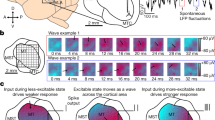Abstract
We have previously proposed that electrocortical waves are linear waves, subject to regulation by mesotelencephalic dopaminergic neurones. As a further means to test this theory, selective unilateral lesions of varying extent were made in the nucleii of origin of the dopaminergic mesotelencephalic tract. Changes in the electrocortical power spectrum were assessed by a repeated measure, between hemispheres comparison of ratio changes in power. With increasing unilateral dopamine cell damage, the animals showed increasing contralateral sensorimotor neglect. Curve fitting the ratio changes in power attributable to lesion, showed that estimates of the power of driving signals and the temporal damping moved in reverse directions with increasing extent of lesion, as expected from the theory. A further test was undertaken, to determine whether equal estimates for a transformation of surface signals were obtained from each side. Equality would not be expected if the equation for relative power were invalid. Left and right equality was found for three grades of unilateral lesion.
Similar content being viewed by others
References
Berkhout J, Walter DO, Adey WR (1969) Alterations of the human electroencephalogram induced by stressful verbal activity. Electroenceph Clin Neurophysiol 27: 457–69
De Ryck M, Teitelbaum P (1978) Neocortical and hippocampal EEG in normal and lateral hypothamic damaged rats. Physiol Behav 20: 403–409
Dunnett SB, Iversen SD (1982) Sensorimotor impairments following localised kainic acid and 6-hydroxydopamine lesions of the neostriatum. Brain Res 248: 121–127
Elul R (1972) The genesis of the EEG. Int Rev Neurobiol 14: 227–272
Furness JB, Heath JW, Costa M (1978) Aqueous aldehyde (Faglu) methods for the fluorescence histochemical localisation of catecholamines and for ultrastructural studies of central nervous tissue. Histochemistry 57: 285–295
Gevins AA, Zeitlin GM, Doyle JC, Yingling CD, Schaffer RE, Callaway E, Yegger CL (1979) Electroencephalogram correlates of higher cortical functions. Science 203 66: 665–667
Hansen MG, Whishaw IQ (1973) The effects of 6-hydroxydopamine, dopamine and dl-norepinephrine on food intake and water consumption, self-stimulation, temperature and electroencephalographic activity in the rat. Psychopharmacologia (Berl) 29: 33–44
Jones BE, Bibillier P, Pin C, Jouvet M (1973) The effect of lesions of catecholamine containing neurones upon monamine content of the brain and EEG and behavioural waking in the cat. Brain Res. 58: 155–177
Konig JFR, Klippel R (1963) The rat brain: a stereotaxic atlas of the forebrain and lower parts of the brain stem. Kreiger, New York
Krieglstein J, Reiger H, Schultz H (1979) Effects of chlorpromazine and some of its metabolites on the EEG and on dopamine metabolism of the isolated perfused rat brain. Eur J Pharmacol 56 (4): 363–70
Lees GJ, Kydd RR, Wright JJ (1985) Relationship between sensorimotor neglect and the specific, degree and locus of mesotelencephalic dopaminergic cell loss following 6-hydroxydopamine. Psychopharmacology (in press)
Lindvall O, Bjorklund A (1974) The organisation of the ascending catecholamine neuron systems in the rat brain as revealed by the glyoxylic acid fluoroescence method. Acta Physiol Scand (Suppl) 412: 1–48
Ljumgberg T, Ungerstedt UL (1976) Sensory inattention produced by 6-hydroxydopamine-induced degeneration of ascending dopaminergic neurones in the brain. Exp Neurol 53: 585–600
Marshall JF (1979) Somatosensory inattention after dopaminedepleting intracerebral 6-OHDA injections: spontaneous recovery and pharmacological control. Brain Res 177: 311–324
Marshall JF, Turner BM, Teitelbaum P (1971) Sensory neglect produced by lateral hypothalamic damage. Science 174: 523–525
Monti JM (1982) Catecholamines and the sleep wake cycle. I EEG and behavioural arousal. Life Sci 30 (14): 1145–57
Neale H, Keane PE (1980) Electrically and chemically induced spindling and slow waves in the encéphale isolé rat: a possible role of dopamine in the regulation of electrocortical activity. Electroceph Clin Neurophysiol 48 24: 318–326
Rouquel A (1982) Psychoactive drugs, animal ECoG and behaviour. Electroceph Clin Neurophysiol (Suppl) 36: 559–565
Valenstein ES, Cox VC, Kakolewski JW (1970) The hypothalamus and motivated behaviour. In: Tapp JT (ed) Reinforcement and behaviour. Academic Press, New York, pp 242–285
Walter DO, Kado RT, Rhodes JJ, Adey WR (1967) Electroencephalographic baselines in astronaut candidates estimated by computation and pattern-recognition techniques. Aerosp Med 38: 371–379
Whishaw IQ, Robinson TE, Schallert T, De Ryck M, Ramirez VD (1978) Electrical activity of the hippocampus and neocortex in rats depleted of brain dopamine and noreponephrine: Relations to behaviour and effects of atropine. Exp Neurol 62: 748–767
Wise RA, Bozarth MA (1981) Brain substrates for reinforcement and drug self-administration. Prog Neuro-Psycho Pharmacol 5: 467–474
Wright JJ, Craggs MD (1979) Intracranial self-stimulation, cortical arousal and the sensorimotor neglect syndrome. Exp Neurol 65: 42–52
Wright JJ, Kydd RR (1984a) A linear theory for global electrocortical activity and its control by the lateral hypothalamus. Biol Cybern 50: 75–82
Wright JJ, Kydd RR (1984b) A test for constant natural frequencies in electrocortical activity under lateral hypothalamic control. Biol Cybern 50: 83–88
Wright JJ, Kydd RR (1984c) Inference of a stable dispersion relation for electrocortical activity controlled by the lateral hypothalamus. Biol Cybern 50: 89–94
Wright JJ, Kydd RR, Lees GJ (1984) Amplitude and phase relations of electrocortical waves regulated by transhypothalamic dopaminergic neurones: A test for a linear theory. Biol Cybern 50: 273–283
Wright JJ, Kydd RR, Lees GJ (1985b) Contributions of noradrenergic neurones of the locus coeruleus to the temporal damping of linear electrocortical waves. Biol Cybern (in press)
Wright JJ, Kydd RR, Lees GJ (1985c) State changes in the brain viewed as linear steady-states and non-linear transitions between steady-states. Biol Cybern (in press)
Author information
Authors and Affiliations
Rights and permissions
About this article
Cite this article
Wright, J.J., Kydd, R.R. & Lees, G.J. Quantitation of a mass action of dopaminergic neurones regulating temporal damping of linear electrocortical waves. Biol. Cybern. 52, 281–290 (1985). https://doi.org/10.1007/BF00355749
Received:
Issue Date:
DOI: https://doi.org/10.1007/BF00355749




